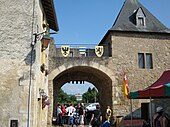
Les Plus Beaux Villages de France (meaning "the most beautiful villages of France") is an independent association created in 1982 for the promotion of the tourist appeal of small rural villages with a rich cultural heritage. As of September 2016, it numbers 156 member villages (independent communes or part of a communauté de communes ). [1] It is affiliated to the international association The Most Beautiful Villages in the World.
Contents
- History
- Principles
- Criteria
- List
- Alsace
- Aquitaine
- Auvergne
- Brittany
- Burgundy
- Centre
- Champagne-Ardenne
- Corsica
- Franche-Comté
- Île-de-France
- Languedoc-Roussillon
- Limousin
- Lorraine
- Lower Normandy
- Midi-Pyrénées
- Nord-Pas-de-Calais
- Pays de la Loire
- Picardy
- Poitou-Charentes
- Provence-Alpes-Côte d'Azur
- Rhône-Alpes
- Upper Normandy
- Overseas departments and territories of France
- See also
- References
- External links
Membership requires meeting certain selection criteria and offers a strategy for development and promotion to tourists. The three initial selection criteria are the rural nature of the village (a population of less than 2,000 inhabitants), the presence of at least two national heritage sites ( sites classés or monuments historiques) and local support in the form of a vote by the council. [2] Each village must pay an annual fee to the association and the mayor must sign the association's Quality Charter. If the village fails to meet the requirements of the charter it may be excluded. [2]
The association claims membership can bring a rise of between 10 and 50% in visitor numbers. [3]
The southern departments of the Dordogne and Aveyron have the most number of member villages, with ten in each. They are followed by Vaucluse, with seven, and Lot, with six.
Following the success of the French certification, similar associations have been formed in Wallonia ( Les Plus Beaux Villages de Wallonie ), Quebec ( Les Plus Beaux Villages du Québec ), Italy ( I Borghi più belli d’Italia ), Japan ( 日本で最も美しい村」連合 Nihon de mottomo utsukushii mura rengō ), Spain ( Los pueblos más bonitos de España ), Russia (Самые красивые деревни России), and Switzerland and Liechtenstein (Les plus beaux villages de Suisse).











































